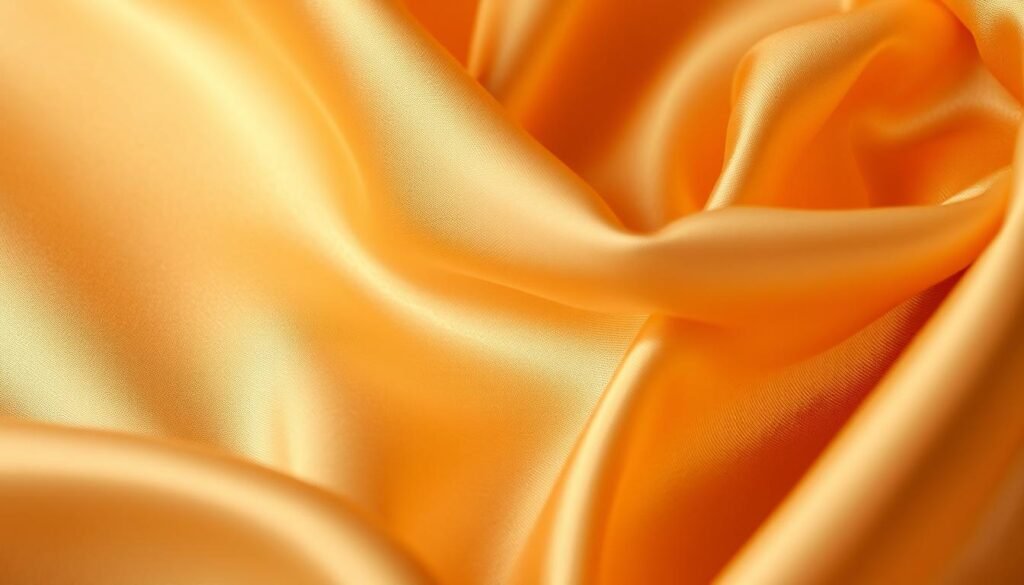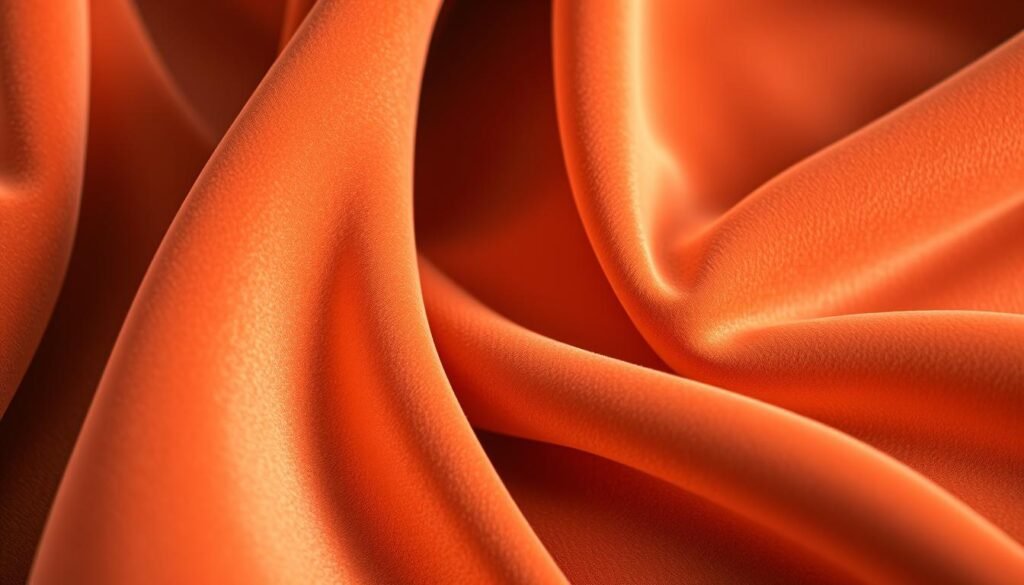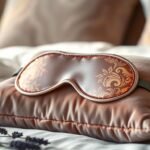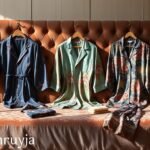In the world of luxury fabrics, silk stands out for its beauty and versatility. From the smooth mulberry silk to the crisp dupioni, silk offers many choices for sewists. But, which silk is best for your project? Learn the secrets of the finest silk types and find your perfect match.
Key Takeaways
- Explore the remarkable diversity of silk fabrics, from the lustrous mulberry silk to the textured dupioni and the fluid satin1.
- Discover the differences between mulberry silk, wild silk, and spun silk2.
- Learn about the unique characteristics, uses, and care requirements of specialty silk blends like silk-cotton and silk-wool1.
- Discover the benefits and applications of different silk fabrics, from the durability of Fuji silk to the soft and fluid drape of Habotai silk1.
- Explore the unique textures and finishes of silk fabrics, from the crisp dupioni to the luxurious velvet13.
Introduction to Silk Fabrics
Silk is a luxurious and versatile natural fiber. It has been loved by fashion and textile lovers for centuries. From delicate chiffons to sumptuous satins, silk fabrics offer many options for sewers and designers. It’s key to know the different silk fabric types, their unique silk weaves, and how they’re made. This includes both traditional silk knits and classic loom-woven techniques.
Understanding Silk Fabric Types by Content, Weave, and Use
Silk fabrics vary by their fiber content, weave, and use. Mulberry silk is a well-known type, coming from domesticated silkworms4. There’s also wild silk, like tussah silk, and spun silk, made from shorter fibers. The silk weaves go from the crisp plain weave to the shiny satin weave, and the textured twill weave5. These silk fabrics are used in many things, from clothes to home decor and industrial products.
Silk Fabrics: Weave vs. Knit Construction
Silk fabrics are either woven or knit. Woven silk fabrics are made on a loom, where threads cross over each other to create patterns like plain weave, twill weave, or satin weave5. On the other hand, silk knits are made on knitting machines. They are soft, stretchy, and drape well, like the jersey knit construction4. Knowing the difference between these methods helps sewers pick the right silk fabric for their projects.
“Silk’s natural luster, softness, and drape make it a coveted fabric for luxury garments and home furnishings. Mastering the nuances of silk fabrics is essential for any aspiring sewist or designer.”
Mulberry Silk vs. Wild Silk and Spun Silk
There are many types of silk fabrics to choose from. Most silk sold is mulberry silk, made by the domesticated mulberry silkworm6. But, there’s also wild silk from other silkworms and spun silk from leftover fibers6. Each type has its own special qualities, giving sewers many options.
Mulberry silk is the top quality silk, known for being soft and smooth7. It’s great for luxury bedding and high-end clothes7. On the other hand, wild silk, like tussah silk, is coarser and drier but lasts longer and doesn’t wrinkle much7. It’s perfect for casual clothes and home decor7.
Spun silk is made from leftover fibers and is cheaper but less shiny than the others6. It’s used for things like pillows and casual wear6.
Choosing the right silk fabric means knowing what each type is like and what it’s best for. Understanding the differences between mulberry, wild, and spun silk helps sewers pick the best for their projects7.
A Fine Lustrous Silk Fabric with a Crisp Texture: The Best Types of Silk
Silk is a top choice for luxury and versatility. It comes from silkworm cocoons. It has many textures and properties that make it great for fashion and home decor8.
Dupioni and Shantung: Textured Plain Weaves
Dupioni and shantung are silk fabrics with a unique look. They have different thread thicknesses for a special sheen. This makes them perfect for fancy clothes8.
Dupion is a medium-weight silk for fancy dresses and evening wear8. Shantung is also medium-weight with a rough feel. It’s great for shirts and trousers8.
Satin: Lustrous and Fluid Silk Fabrics
Silk satin and charmeuse have a shiny, flowing look. They’re perfect for elegant dresses and evening wear8. Charmeuse is a light silk for blouses and lingerie8.
Sandwashed silk satin has a soft, matte look. It’s a nice choice if you don’t like shiny fabrics8.

“Silk fabrics are generally luxurious and light- to medium-weight with a shiny, lustrous finish.”8
Duchesse Satin: The Pearly Bridal Favorite
Duchesse satin is a top choice for fancy wedding dresses and formal gowns. It’s a silk fabric known for its heavy feel and unique shine. This makes it perfect for elegant, tailored outfits9.
It’s very soft and flows well, great for certain styles like full skirts and bias cuts9. But, it’s not the best for flowing, draped looks because it’s quite thick.
Many bridal designers and formal wear fans love duchesse satin for its luxury look and feel9. It’s super soft and flows well, ideal for certain styles9. Its stiffness and shine are great for structured, tailored looks in high-end wedding dresses and evening gowns9.
Duchesse satin isn’t just for weddings and formal events. It’s also great for many other items and projects10. You can use it for blouses, dresses, skirts, jackets, hats, drapes, and accessories like shoes and belts10. Its fancy sheen and structured feel make it perfect for anyone wanting a high-end, sophisticated look.
Crêpe Fabrics: Pebbled Texture and Matte Sheen
Silk crêpe fabrics, like crêpe de Chine and crêpe georgette, are famous for their unique pebbled texture and matte sheen11. Crêpe de Chine has a subtle crêpe texture with a slight shine. It’s great for many uses because it’s soft and easy to care for11. On the other hand, crêpe georgette is thicker and heavier. It has a matte, pebbled look perfect for summer dresses and scarves11.
Crêpe Georgette: Drapey Crêpe Goodness
Silk crêpe fabrics are great for making flowing clothes because they drape well11. Crêpe georgette is especially good for making elegant, easy designs11. Its matte sheen and pebbled texture make it stand out. At the same time, it drapes beautifully, making it look great on the body11.
For sewing a summer dress or a stylish scarf, silk crêpe fabrics like crêpe de Chine and crêpe georgette are perfect11. They have a unique texture and matte sheen. This makes them a top choice for fashion designers and those who love clothes11.
“Silk crêpe fabrics are a true delight to work with, offering a unique and sophisticated look for any garment or accessory.”
| Silk Crêpe Fabric Type | Texture | Sheen | Drape | Ideal Uses |
|---|---|---|---|---|
| Crêpe de Chine | Subtler crêpe texture | Slight sheen | Supple and drapey | Versatile for various applications |
| Crêpe Georgette | Matte, pebbled texture | Matte sheen | Drapey and flowing | Elegant summer frocks, scarves |
Marocain: Luxurious Heavy Crêpe
Silk marocain, also known as 4 ply silk, is a top choice for luxury. It has a matte sheen and a soft, thick feel. This makes it perfect for formal clothes, like wedding dresses12.
This fabric is part of the silk crêpe fabrics family. It includes silk crêpe de Chine and silk crêpe georgette12. These fabrics look textured but are different in many ways.
- Silk crêpe de Chine is a bit subtle, with a slight shine12.
- Silk crêpe georgette is thicker than usual, with a simple weave and twisted threads. It looks fairly see-through, especially in light colors12.
Silk crêpe fabrics are great for draping well and making ruched looks. But, they’re not good for structured clothes12. They’re light, have a matte look, and need some sewing skill12.
Silk crêpe fabrics are used in many clothes, from casual tops to skirts and scarves12.
“Silk marocain is a true testament to the artistry and craftsmanship of the silk industry, offering a level of elegance and sophistication that few other fabrics can match.”
| Silk Fabric Type | Characteristics | Common Uses |
|---|---|---|
| Silk Marocain | Heavy, dense crêpe fabric with a matte sheen and substantial drape | Formal wear, especially wedding dresses |
| Silk Crêpe de Chine | Subtler, half-crêped fabric with a slight sheen | Casual tops, tunics, scarves |
| Silk Crêpe Georgette | Heavier than ordinary georgette, with a plain weave and twisted crêpe threads, fairly sheer | Blouses, delicate skirts |
Looking to make a timeless wedding dress or an elegant evening gown? Silk marocain is a great choice. It’s luxurious, with a heavy feel and a matte look12.
Charmeuse and Chiffon: Lightweight Silk Bliss
Silk charmeuse and silk chiffon are top picks for their ethereal and luxurious feel. They are light, flowy, and have a beautiful sheen. This makes them perfect for blouses and evening wear13.
Silk charmeuse has a satin weave for a smooth, shiny look. Silk chiffon is sheer and light, feeling like gossamer. Both fabrics are tricky to sew because they are so light and see-through13.
Designers and fashion lovers love these lightweight silk fabrics for their luxury. They add an easy elegance to many outfits. Silk charmeuse and silk chiffon make evening dresses and blouses look amazing13.
If you want a fabric for a special event or something light for summer, check out silk charmeuse and silk chiffon. These sheer silk fabrics are a dream for anyone who loves fashion. They bring a timeless beauty that always looks good13.
Taffeta: Crisp and Rustling Elegance
Silk taffeta is a smooth, crisp fabric with a shiny finish. It makes a rustling sound when worn14. It started in the twelfth century in the Middle East, from the Persian “taftah” meaning “crisp, woven”14. Famous designers like Coco Chanel and Christian Dior love it for its quality and beauty14.
Sewing Tips for Taffeta
Taffeta can be hard to work with because it wrinkles easily and can only be stitched once14. To get a smooth look, sewers should handle it gently and use French seams14. Its stiffness makes it flow beautifully, perfect for evening dresses and special outfits14.
Taffeta is great for making dramatic designs because of its flow14. It comes in over fifty colors14. You can find it in many types of dresses, jackets, and even corsets14.
| Fabric | Content | Width | Weight | Features | Applications |
|---|---|---|---|---|---|
| Heavy Silk Taffeta | 100% Silk | 58/60″ | Heavy-weight | Tightly woven, durable, elegant drape, holds shape well | Apparel, bridal, cosplay, costume, dress, fashion, furniture, sari, upholstery |
Heavy silk taffeta is strong and has a beautiful drape15. Its tightly woven silk makes it stiff, perfect for keeping shapes15. It comes in many colors, making it great for many uses, from clothes to furniture15.
“Taffeta has been celebrated for centuries for its quality and elegance in garment creation.”
When sewing a fancy dress or a simple blazer, knowing how to work with silk taffeta is key14. With the right techniques and attention to detail, this fabric can make any garment look elegant14.
Velvet: Plush Luxury
Silk velvet is a fabric that looks and feels very fancy16. It’s soft and shiny, making it great for fancy clothes and home decor16. Now, it’s not just for kings and queens anymore. Everyone can enjoy its fancy feel.
This fabric is thick and feels very fancy because of its soft pile16. It’s perfect for many things like fancy dresses and home furniture16. You can find it in fancy clothes and home items, adding a touch of silk velvet luxury.
The best kind of velvet is made from silk16. But, you can also find it in cotton, viscose, rayon, or synthetic materials16. Silk velvet is the top choice because it’s the softest and shiniest16. When sewing with it, be careful because you can only sew it once. Also, ironing it too much can ruin its soft feel.

Velvet is back in style, with bright colors and deep tones being popular16. You can use silk velvet in clothes and home decor16. It looks great on a fancy sofa or a long evening dress, adding a touch of luxury to anything it touches.
“Velvet is the ultimate in luxury, and it’s a fabric that has stood the test of time. Its rich, velvety texture and lustrous sheen make it a timeless choice for those who appreciate the finer things in life.”
Specialty Silk Blends
There are special silk blends that mix silk with other natural fibers. Silk-cotton, silk-linen, and silk-wool mixes have unique textures and draping qualities. They blend silk’s softness, sheen, and breathability with other fibers’ structure and durability17. These fabrics are used for high-end clothes and accessories. They meet the needs of those who want the best of both worlds.
Silk-Cotton, Silk-Linen, and Silk-Wool Mixes
Silk-cotton blends mix the light, airy nature of cotton with silk’s smooth, shiny feel18. This makes a fabric that’s comfy and looks good. It’s a top pick for summer clothes and accessories.
Silk-linen blends give a structured look while keeping silk’s softness and drape17. Linen adds a crisp, natural beauty. These fabrics are great for tailored clothes and home decor.
Silk-wool mixes add warmth and luxury with wool’s insulating qualities and silk’s sheen and softness17. These are used for high-end sweaters, scarves, and suits. They offer a cozy yet elegant look and feel.
| Silk Blend | Key Properties | Common Uses |
|---|---|---|
| Silk-Cotton | Lightweight, breathable, lustrous | Summer clothing, accessories |
| Silk-Linen | Structured, textured, soft drape | Tailored garments, home furnishings |
| Silk-Wool | Warm, insulating, luxurious | Sweaters, scarves, suiting |
These silk blends have a special mix of properties. They let fashion designers and home decor lovers make high-quality, attractive, and useful items. Whether it’s silk-cotton’s breathability, silk-linen’s elegance, or silk-wool’s warmth, these silk fabrics offer endless chances to make luxurious and versatile clothes and home textiles.
Conclusion
This article has taken you on a journey through the world of silk fabrics. We’ve looked at the unique traits and uses of many silk types. You now know about the crisp dupioni and shantung19, the smooth satin, and the soft velvet. You can pick the right silk for your sewing projects, like fancy clothes, everyday wear, or home decor.
We also talked about the long history and global importance of silk fabric. It started in China and spread around the world20. You learned why silk is so loved, with its strength, ability to keep moisture away, and design flexibility20. We covered everything from the classic mulberry silk to the rare Muga silk from Assam, India21.
Now, you’re ready for your next sewing with silk project. It could be a fancy dress, a light scarf, or a rich home decor item. This article has given you the knowledge and confidence to choose the best silk for your project. Let your creativity shine with this amazing fabric.
FAQ
What are the main types of silk fabrics?
There are three main types of silk fabrics. These include mulberry silk, wild silk, and spun silk. They can be made into many fabrics like dupioni, shantung, satin, charmeuse, chiffon, taffeta, and velvet.
What is the difference between mulberry silk, wild silk, and spun silk?
Mulberry silk comes from the domesticated mulberry silkworm. Wild silk, like tussah silk, comes from other silkworm species. Spun silk is made from leftover fibers after silk production.
What are the unique characteristics of dupioni and shantung silk?
Dupioni and shantung are textured fabrics with a special look. They have different thread thicknesses in the warp and weft. This gives them a lovely sheen and makes them great for tailored clothes.
How do satin and charmeuse silk differ in their properties?
Satin silk is known for its shiny, flowing look. It’s perfect for elegant evening wear. Charmeuse silk is also satin but has a smooth, shiny surface.
What is special about duchesse satin silk?
Duchesse satin is a heavy, stiff satin with a pearly sheen. It’s often used in high-end wedding dresses and formal gowns because of its structured look.
What are the distinctive features of crêpe silk fabrics?
Crêpe silk fabrics, like crêpe de Chine and crêpe georgette, have a textured look and a matte sheen. Crêpe de Chine is subtle, while crêpe georgette is thicker and heavier.
What is silk marocain or 4 ply silk?
Silk marocain, also called 4 ply silk, is a thick, luxurious crêpe with a matte sheen. It’s made from fine silk threads and is great for formal wear, especially wedding dresses.
How do silk charmeuse and chiffon differ in their properties?
Charmeuse is a satin silk with a shiny surface. Chiffon is a sheer silk with a light, airy feel. Both are used for blouses, dresses, and evening wear.
What are the unique characteristics of silk taffeta?
Silk taffeta is a crisp fabric with a shiny finish and a rustling sound. It’s often used for dresses and evening wear. But, it can be hard to sew because it wrinkles easily.
What makes silk velvet a luxurious fabric choice?
Silk velvet is a thick fabric with a soft, plush texture. It has a rich, velvety feel. This makes it perfect for elegant clothes and home decor.
What are the benefits of silk blend fabrics?
Silk blends mix silk with other fibers like cotton, linen, and wool. This creates unique textures and draping. These fabrics are used for high-end clothes and accessories.




